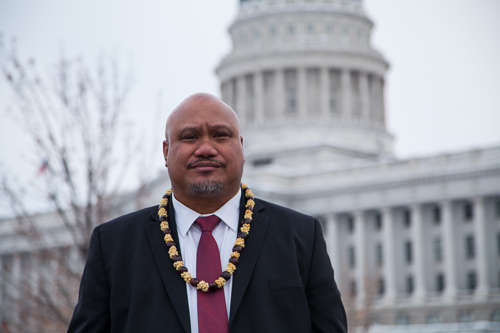Category: Analysis
U.S. Citizenship and Justice for American Samoa
 On March 16, 2021, Aumua Amata Coleman Radewagen, a non-voting congressional delegate for American Samoa, introduced House Resolution 1941 – To amend the Immigration and Nationality Act to waive certain naturalization requirements for United States nationals, and for other purposes. This bill would allow eligible U.S. Nationals in Outlying Possessions to become citizens upon establishing residence and physical presence in those territories. It would also waive certain other naturalization requirements for non-citizen nationals, who currently need to become a resident of a U.S. state to qualify. The mere existence of this bill raises questions about the nature of the relationship between America and its “Outlying Possessions” like American Samoa. Why are the inhabitants of Tutuila, the Manuʻa Islands, Rose Atoll, and Swains Island called “American” Samoans when they are not born with equal legal status to other Americans?
On March 16, 2021, Aumua Amata Coleman Radewagen, a non-voting congressional delegate for American Samoa, introduced House Resolution 1941 – To amend the Immigration and Nationality Act to waive certain naturalization requirements for United States nationals, and for other purposes. This bill would allow eligible U.S. Nationals in Outlying Possessions to become citizens upon establishing residence and physical presence in those territories. It would also waive certain other naturalization requirements for non-citizen nationals, who currently need to become a resident of a U.S. state to qualify. The mere existence of this bill raises questions about the nature of the relationship between America and its “Outlying Possessions” like American Samoa. Why are the inhabitants of Tutuila, the Manuʻa Islands, Rose Atoll, and Swains Island called “American” Samoans when they are not born with equal legal status to other Americans?
In 1900, the United States and the German Empire unceremoniously partitioned Samoa between themselves. Neither had conquered their respective portion from one another, the prior British claimants, or even the native population. By the dawn of the 20th Century, apparently, western dominion was such a foregone conclusion that neither empire bothered to do much actual colonizing. The U.S., the Kaiserreich, and the British Empire decided the fate of the Samoans in a Washington D.C. conference overseen by Oscar II, King of Sweden and Norway. No one invited any Samoans. The U.S. still claims sovereignty over its gains from this treaty. These five main islands (and two atolls) now constitute the unincorporated, unorganized territory of the United States known as American Samoa.
The United States possesses 16 territories, but only 5 are home to permanent populations. These are American Samoa, Guam, the Northern Mariana Islands, Puerto Rico, and the U.S. Virgin Islands. The Supreme Court decided the unincorporated status of these territories in the 1901 Insular Cases, summarized by Stacey Plaskett of the Atlantic:
In a series of highly fractured and controversial decisions known collectively as the Insular Cases, the Supreme Court invented an unprecedented new category of “unincorporated” territories, which were not on a path to statehood and whose residents could be denied even basic constitutional rights. Which territories the Court determined were “unincorporated” turned largely on the justices’ view of the people who lived there—people they labeled “half-civilized,” “savage,” “alien races,” and “ignorant and lawless.”
While the other 4 unincorporated territories face legal challenges, all except American Samoa are organized. The full U.S. constitution does not apply in organized territories, and their congressional delegates are nonvoting. However, residents of organized territories are at least American citizens. Unique among permanently populated U.S. territories, American Samoa’s people are not citizens. At birth, they receive the lesser status of non-citizen U.S. National. U.S. Nationals cannot vote in elections held in the 50 states. People born in other territories, like Puerto Rico, are citizens and can vote in these elections. American Samoa is the only permanently inhabited territory of the U.S. whose people are not American citizens.
Lesser voting rights are not the only difference between American citizens and nationals. Despite claims from sources such as the National Conference of State Legislatures that “There’s not much difference between the two designations,” American Samoans face unique legal challenges as described by Temple Law Professor Tom C.W. Lin:
However, unlike the other Territories, where Congress conferred citizenship to the people of each Territory, Congress enacted no such enabling act for the people of American Samoa. Accordingly, American Samoans are non-citizen nationals of the United States. They reside in an “interstitial” space in law and fact, with some, but not all, of the rights and privileges that accompany citizenship. As non-citizen nationals, American Samoans are ineligible for many government jobs, benefits, and privileges that are afforded only to citizens of the United States.
To be a second-class citizen, one has to at least be a citizen. In the current legal framework, U.S. national Samoans are second-class Americans.
This legal status is not simply a forgotten artifact of gilded-age American imperialism. In 2012 Leneuoti Tuaua, prohibited from police work in California because of his non-citizen national status, filed suit against the State Department and the Obama administration. His counsel argued that the citizenship clause of the 14th amendment (“All persons born or naturalized in the United States, and subject to the jurisdiction thereof, are citizens of the United States”) guaranteed those born in American Samoa citizenship without the need for approval by Congress. Citing the 1901 Insular Cases, the U.S. Court of Appeals for the District of Columbia ruled 3-0 that only Congress could grant citizenship to non-citizen nationals. The Supreme Court denied certiorari. In 2019, John Fitisemanu challenged the “federal policy [requirement] that his U.S. passport include a disclaimer in all capital letters that ‘THE BEARER IS A UNITED STATES NATIONAL AND NOT A UNITED STATES CITIZEN.’” His counsel too argued that the citizenship clause of the 14th Amendment guarantees birthright citizenship to American Samoans. A Utah district court agreed with Fitisemanu, but the 10th Circuit Court of Appeals reversed. The Fitisemanu plaintiffs sought a sought a rehearing en banc but the court denied the motion in December, 2021.
It is unlikely the current Supreme Court will grant certiorari. The Court has made its position clear: only Congress can alter the status of those born in unorganized territories. Another complication arises in that blanket citizenship does not see universal support among American Samoans. Along with religious concerns, some believe an organizing act would upset traditional land ownership. The islands’ government employs Samoan ancestry requirements to keep land in the hands of native families. These requirements would likely be held unconstitutional if all American Samoans were made citizens. This could potentially lead to wealthy outsiders and corporations buying out locals, threatening the American Samoans’ cultural and economic way of life. As such, Delegate Radewagen’s H.R. 1941 represents a worthy compromise. It would greatly reduce barriers to citizenship for U.S. National Samoans, while also preserving a legal system that allows them to carry on their traditional way of life. Delegate Radewagen’s proposed bill was sent to the House Subcommittee on Immigration and Citizenship in May 2021. Congress should pass this legislation to give American Samoans back the individual right to self-determination denied to them over 100 years ago.
 James Hallisey anticipates graduating from Boston University School of Law in May 2023.
James Hallisey anticipates graduating from Boston University School of Law in May 2023.
US Policy Options for the No-Longer-Imaginary “Climate Refugee”
Rising sea levels, intense hurricanes, and dangerous flooding can cause sudden upheavals of individuals’ lives, making homes and entire areas uninhabitable for families or entire communities – sometimes, very suddenly. These “climate refugees” are often spoken in future terms, but they already exist; but the law in most places does not differentiate them from economic migrants who are seeking better jobs and living conditions. Governments, including the United States, have not redefined “refugees” to include those fleeing natural disaster, let alone climate change. The US should begin to rethink the concept of a refugee and put in place protections for those displaced by climate change.
 The United Nations Refugee Convention set the definition for a refugee in 1951: someone outside their country of nationality or residence with a well-founded fear of persecution on the basis of race, religion, nationality, membership of a particular social group or political opinion, without the ability to seek protection in that country. Meeting this criteria entitles one to international protections such as non-refoulement: the practice of avoiding forcing refugees to return to countries where they have a high risk of persecution. The definition of a refugee rests wholly on persecution and makes no mention of natural disaster or climate-related factors.
The United Nations Refugee Convention set the definition for a refugee in 1951: someone outside their country of nationality or residence with a well-founded fear of persecution on the basis of race, religion, nationality, membership of a particular social group or political opinion, without the ability to seek protection in that country. Meeting this criteria entitles one to international protections such as non-refoulement: the practice of avoiding forcing refugees to return to countries where they have a high risk of persecution. The definition of a refugee rests wholly on persecution and makes no mention of natural disaster or climate-related factors.
One major complication that arises from climate refugee policy is that it is very unlikely that one dramatic event will push a family out of its home country. Rather, ongoing drought and extreme heat due to climate change result in unsustainable conditions in which families cannot make a living or gain meaningful quality of life. Drought may cause crops to fail, and a family may be forced to move somewhere where they need not depend on farming. This makes it difficult to distinguish between those relocating to new countries due to climate change versus pure economic factors, and these individuals are deemed “economic migrants” no matter the root cause of their flight.
Another factor is the lack of incentive for national governments to go beyond the minimum requirements for refugee status set long ago in the UN Convention, despite the worsening natural disasters and living conditions due to climate change. In 2018, a majority of the UN General Assembly affirmed the Global Compact on Refugees, which strives toward addressing the interactions between climate, environmental degradation, and disasters, and refugee movements; this is not a binding agreement that alters the original 1951 Convention, however, and it tends to focus only on instances where climate change causes conflict and persecution (entitling one to classic refugee protections) rather than threats to life due to rising temperatures.
Climate refugees already exist. Kiribati is a South Pacific island nation that is in danger of losing its entire landmass to rising sea levels due to climate change. In 2015, a Kiribati national, Ioane Teitiota, applied for “climate refugee” status with the New Zealand government, but this application was rejected and he was repatriated to Kiribati. A subsequent complaint with the UN resulted in the New Zealand government’s decision being upheld due to a lack of “imminent threat” to life, though the UN did acknowledge the serious threat to the human right to life posed by climate change. Since then, New Zealand has pledged to offer up to 100 special climate refugee visas to Pacific Islanders in the future.
Mr. Teitiota's application would have gotten the same result with almost any national government, including the United States. National governments have largely matched their own domestic refugee policy to the 1951 UN definition and have avoided changing it since the treaty was signed over 70 years ago. The U.S. Citizenship and Immigration Services (USCIS) Refugee Eligibility criteria match this definition, as does the legal definition of “refugee” in the Immigration and Nationality Act enacted in 1952. USCIS explicitly states that “If you are fleeing a civil war or natural disaster, you may not be eligible for resettlement under U.S. law. However, you may fall within the protection of the United Nations High Commissioner for Refugees (UNHCR).” While “natural disaster” could mean climate change, the UHNCR states that “climate refugees” may only meet the definition of a refugee and be eligible for the associated protections when the “adverse effects of climate change interact with armed conflict and violence.” The UNHCR expressly does not endorse the term “climate refugee,” but rather “persons displaced in the context of disasters and climate change.” This leaves those displaced by climate change without refugee protection from either USCIS or UNHCR.
 Congress has not frequently passed dramatic changes to U.S. immigration law; arguably, the last major legislation was during the Reagan administration in 1986, when Congress passed the Immigration Reform and Control Act making it a criminal offense for employers to hire undocumented migrants, offering legal status to some undocumented migrants who had been in the U.S. before 1982, and increasing security-based deterrence measures at the southern border. Clearly, this deterrence approach did not work, and each president since then has reckoned with issues of immigration, resulting in disjointed, easy-come-easy-go executive policy made up of executive orders and administrative measures under sitting presidents. Shortly after taking office, President Biden issued an executive order with the goal of starting the process to reorganize the U.S. refugee resettlement program to allow “climate refugees” by ordering an interagency report. This report highlighted the lack of climate change refugee resettlement channels, but offered the possibility of granting case-by-case parole for climate affected individuals as a short-term solution. Additionally, the report cited measures by other countries, such as humanitarian visas, labor mobility schemes, and education programs or sponsorships accessible to refugees and other forcibly displaced persons, which provide a path to permanent residency. None of these are long-term policy solutions, but rather seek to squeeze climate refugees into existing policy in any way they may fit. Even if the Biden administration does continue these efforts to protect climate refugees, these measures are easily undone by subsequent administrations.
Congress has not frequently passed dramatic changes to U.S. immigration law; arguably, the last major legislation was during the Reagan administration in 1986, when Congress passed the Immigration Reform and Control Act making it a criminal offense for employers to hire undocumented migrants, offering legal status to some undocumented migrants who had been in the U.S. before 1982, and increasing security-based deterrence measures at the southern border. Clearly, this deterrence approach did not work, and each president since then has reckoned with issues of immigration, resulting in disjointed, easy-come-easy-go executive policy made up of executive orders and administrative measures under sitting presidents. Shortly after taking office, President Biden issued an executive order with the goal of starting the process to reorganize the U.S. refugee resettlement program to allow “climate refugees” by ordering an interagency report. This report highlighted the lack of climate change refugee resettlement channels, but offered the possibility of granting case-by-case parole for climate affected individuals as a short-term solution. Additionally, the report cited measures by other countries, such as humanitarian visas, labor mobility schemes, and education programs or sponsorships accessible to refugees and other forcibly displaced persons, which provide a path to permanent residency. None of these are long-term policy solutions, but rather seek to squeeze climate refugees into existing policy in any way they may fit. Even if the Biden administration does continue these efforts to protect climate refugees, these measures are easily undone by subsequent administrations.
A number of policy options are available to the United States to rectify the absence of protections for climate refugees. In addition to parole or humanitarian visas, the U.S. could, as it has done before, instruct agencies to grant refugee status even when an individual does not strictly meet the definition of a “refugee.” The most common criteria disregarded under these conditions is the requirement that one be outside their country of origin. This adjustment could be very beneficial to climate refugees. Agencies could also stretch the meaning of existing “persecution” based definitions to somehow include climate change, though this may be limited to situations where drought, natural disaster, and other factors lead to actual conflict.
The most long-term solution would be the first sweeping immigration legislation to be passed since Reagan: a change to the legal definition of a “refugee” set out under the 1952 Immigration and Nationality Act to one that includes climate change, or specifically sets out a definition of “climate refugee.” Such a piece of legislation goes beyond the UN Covenant, so the United States and other UN members currently lack incentives to initiate it, but sadly incentives may change globally as climate refugees grow in numbers due to worsening conditions.
 Carly Gillingham anticipates graduating from Boston University School of Law in May 2022.
Carly Gillingham anticipates graduating from Boston University School of Law in May 2022.
The Legality of Ranked Choice Voting
For a number of reasons, Jared Golden (D-ME) made national news when he was elected to represent Maine’s second congressional district (CD-2). First, CD-2 is roughly ten points more conservative than the nation as a whole and voted for former President Trump twice. Second, his victory meant the Democratic party would occupy all of New England’s House seats. Third, his election was the first time that CD-2 failed to elect an incumbent running for re-election in over 100 years. Finally, through the mechanics of Maine’s Rank-Choice Voting (RCV) system, Golden won despite initially having 2000 votes fewer than incumbent Bruce Poliquin. Poliquin filed a slew of lawsuits challenging the constitutionality of RCV, but Golden was ultimately seated.
As more jurisdictions begin to consider implementing RCV, both state and federal courts will have to determine the legal contours of RCV. This blog post will briefly describe the history and mechanics of RCV before surveying the serious challenges RCV has faced and will continue to face at both the state and federal level.
What is RCV and How Did it End Up in Maine?
RCV is a voting system that allows voters to pick a preferred order of candidates for any given position. If one candidate is the first choice of more than 50% of the voters, they are the winner of the election. However, if no candidate successfully secures 50% of first-choice ballots, the candidate with the fewest votes is eliminated. Officials then conduct a new round of counting, redistributing votes for the eliminated candidate(s) based on each effected ballot’s second choice. The process repeats itself until one candidate has at least 50% of the vote.
Proponents of RCV claim that it improves voter turnout, minimizes negative campaigning, and increases faith in elections. It also prevents candidates from winning elections who are actively disliked by the majority of voters. With states often being the laboratories for legislative policy, Maine was an obvious choice for targeting passage. Maine has a long history of electing independent politicians or voting heavily for third party candidates. Between Independent Jim Longley’s victory in 1974 with only 39.7% of the vote and the enactment of RCV in 2016, only two governors have been elected with a majority of the vote.
Although Maine’s affinity for independent-minded politicians often results in politically moderate governors, Paul Lepage, a Tea Party favorite and self-proclaimed “Trump before Donald Trump became popular,” was elected in 2012 with 37% of the vote. With shocking disapproval numbers for the new governor, advocates pitched RCV as a way to preserve Maine’s unique history of voting for third-party candidates while also preventing unpopular figures from claiming the governorship. In 2016, voters passed an initiative implementing RCV for all elections.
Source of Constitutionality Concerns
 In the five years since Maine voters passed RCV, opponents have levied a number of legal attacks against RCV. These attacks have typically followed two main theories: that the system violates the federal ‘one person one vote’ doctrine, or that it runs afoul of state constitutional language that implies the winner of an election need not have a majority of the vote.
In the five years since Maine voters passed RCV, opponents have levied a number of legal attacks against RCV. These attacks have typically followed two main theories: that the system violates the federal ‘one person one vote’ doctrine, or that it runs afoul of state constitutional language that implies the winner of an election need not have a majority of the vote.
One Person One Vote and Burdens on the Right to Vote
Article 1 Section 4 of the Constitution grants states broad discretion to choose “[t]he Times, Places, and Manner of holding Elections for [federal] Senators and Representatives”. Having a novel method of electing officials is not per se unconstitutional, so Poliquin’s lawsuit claimed that RCV violates the federal right to vote. He argued that voters whose initial preferences are eliminated get to vote more than once – once in the initial round, and again in each subsequent round where their second, third, or even fourth preference is counted. In Baber v. Dunlap (D. Me. 2018), Judge Lance E. Walker was not sympathetic. Judge Walker found that those who voted for Poliquin as their first choice had their votes counted just as much as those who voted for disqualified candidates and whose votes were distributed to second choices. Ultimately, he found that the process did not dilute or make irrelevant the votes listing Poliquin or Golden as a first choice.
Poliquin also argued that the Constitution requires the winners of federal offices to be determined by the plurality of the votes. Walker, a Trump appointee, found that Article I of the Constitution does not require states to declare winners based on the winner of the plurality vote: “There is no textual support for this argument and a great deal of historical support to undermine it.” For example, Judge Walker noted that several states require majority votes for elections through the use of run offs, yet these schemes have never been closely scrutinized under Article I. With respect to the plain text, Walker was equally unequivocal in his conclusion: “The framers knew how to distinguish between plurality and majority voting, and did so in other contexts in the Constitution, which leads to the sensible conclusion that they purposefully did not do so in Article I, section 2.”
Other jurisdictions have agreed RCV does not violate the Constitution. The 9th Circuit, ruling on San Francisco’s RCV scheme, stated “the City’s restricted [RCV] system is not analogous to limitations on voting in successive elections, because in San Francisco’s system, no voter is denied an opportunity to cast a ballot at the same time and with the same degree of choice among candidates available to other voters.” Thus, the weight of legal authority indicates that the Constitution does not prohibit states from implementing RCV.
State Constitutionality
 Upon Maine’s enactment of RCV, the Maine senate asked the Maine Supreme Court for an advisory opinion on RCV’s constitutionality. Specifically, the Senate President was concerned about the state constitution’s language requiring the winners of state positions to be determined by a “plurality of all the votes.” In their opinion, the Court recognized that although citizen-enacted laws enjoy a “heavy presumption” of constitutionality, “the language of the Maine Constitution . . . is clear.” The Court found clarity particularly in light of the history of the Constitution’s text – which was changed to the current language after a series of run-off elections caused confusion, anger, and a violent confrontation on the steps of the state house in 1879. Out of respect for this history, the Justices believed they had no choice but to avoid any construction that failed to seat any state office candidate winning the plurality of the vote. Thus, even though RCV can be used for federal elections and all primaries in Maine, it may not be utilized in the general elections for state positions.
Upon Maine’s enactment of RCV, the Maine senate asked the Maine Supreme Court for an advisory opinion on RCV’s constitutionality. Specifically, the Senate President was concerned about the state constitution’s language requiring the winners of state positions to be determined by a “plurality of all the votes.” In their opinion, the Court recognized that although citizen-enacted laws enjoy a “heavy presumption” of constitutionality, “the language of the Maine Constitution . . . is clear.” The Court found clarity particularly in light of the history of the Constitution’s text – which was changed to the current language after a series of run-off elections caused confusion, anger, and a violent confrontation on the steps of the state house in 1879. Out of respect for this history, the Justices believed they had no choice but to avoid any construction that failed to seat any state office candidate winning the plurality of the vote. Thus, even though RCV can be used for federal elections and all primaries in Maine, it may not be utilized in the general elections for state positions.
Conclusion
Following the Maine Supreme Court’s advisory opinion, the Maine legislature has tried to amend the state constitution to allow for RCV for state general election. Even if such efforts are successful in Maine, RCV faces challenges elsewhere. The Supreme Court of Alaska, the only other state with RCV, is heard a case on RCV’s constitutionality in January 2022. Meanwhile, voters in Massachusetts turned down RCV at the ballot box. Thus, RCV faces seriously political and legal hurdles to gaining widespread implementation.
 Spencer Shagoury anticipates graduating from Boston University School of Law in May 2022.
Spencer Shagoury anticipates graduating from Boston University School of Law in May 2022.
Here Comes the Sun?
On March 12, 2021, a bipartisan coalition of Senators reintroduced the Sunshine Protection Act, a bill that would make daylight saving time permanent across the country. Leading sponsors include Ed Markey (D-Mass.) and Marco Rubio (R-Fla.). This legislation would not only eradicate the disruption created by changing our clocks twice a year, but would also result in more afternoon and evening daylight for everyone around the country. This is not the first attempt to make daylight saving time permanent; bills to end the time changes have been introduced in Congress and in state legislatures with little success. A similar bill was introduced in the Senate in 2019. In 2019 and 2020, thirty-two states, including Massachusetts, proposed legislation to make daylight savings permanent.
Daylight Saving in the United States
Daylight saving was instituted in America during World War I. Germany became the first country to institute the change in 1916

Ohio Clock in the U.S. Capitol being turned forward for the first U.S. daylight saving time on March 31, 1918.
as a way to conserve fuel. England and America followed shortly after in 1918, believing that more daylight during the workday would reduce coal usage and thus save energy. Evidence that it saves energy is slim, however, as lighting has become increasing energy efficient.
President Woodrow Wilson wanted to keep daylight savings after the war ended, but anecdotally received pushback from farmers who would lose an extra hour of light in the morning. The darker mornings made it more difficult for them to get their products to market, and often negatively affected their livestock. It was eventually abolished, but then reinstated by President Roosevelt during World War II.
After World War II ended, states retained the power to decide whether to observe daylight saving time. In 1966, Congress enacted the Uniform Time Act for states that had chosen to observe daylight saving. The Act designated uniform dates on which daylight saving would begin, so as to prevent confusion in travel and broadcasting.
Let the Sunshine in
The time has come to make daylight saving permanent. Changing our clocks twice a year causes unnecessary stress and confusion, and losing valuable daylight in the dreary winter months is an unwelcome side effect.
First, research has shown that changing our clocks in the fall contributes to an increase in Seasonal Affective Disorder among the population. Scientists believe that shorter days and reduced sunlight in the winter trigger biochemical changes in the brain. Many have even suggested light therapy (exposure to a light box that simulates high-intensity sunlight) as treatment for depressive disorders. The effects of darkness on our mental health have only been worsened by the COVID-19 pandemic. Many people who found solace in evening walks, exercising, or general outdoor time lost those outlets and motivation when they lost daylight in November. Making daylight saving permanent would improve our mental health by increasing opportunities to get sunlight every day, and by providing more time for healthy outdoor activities.
 Second, eliminating time changes would have a number of other health and safety benefits. Aligning daylight with workers’ standard hours would increase visibility during busy driving times, helping prevent crashes. Additionally, research has shown that the number of car crashes spike in the week following the spring time change. Abolishing the change would eliminate the stress and confusion that accompanies sudden changes to work schedules. Furthermore, making daylight saving permanent would shift busy driving hours away from certain animals’ nocturnal hours, thereby reducing vehicle collisions with wildlife. Research has also suggested that transitions in and out of daylight saving time disrupt circadian rhythms and lead to increased risk for heart attacks and strokes. More daylight in the evenings also reduces your risk of being the victim of a robbery.
Second, eliminating time changes would have a number of other health and safety benefits. Aligning daylight with workers’ standard hours would increase visibility during busy driving times, helping prevent crashes. Additionally, research has shown that the number of car crashes spike in the week following the spring time change. Abolishing the change would eliminate the stress and confusion that accompanies sudden changes to work schedules. Furthermore, making daylight saving permanent would shift busy driving hours away from certain animals’ nocturnal hours, thereby reducing vehicle collisions with wildlife. Research has also suggested that transitions in and out of daylight saving time disrupt circadian rhythms and lead to increased risk for heart attacks and strokes. More daylight in the evenings also reduces your risk of being the victim of a robbery.
Third, making daylight saving permanent would have economic benefits. Studies have shown that economic activity drops when the clocks move back. Making daylight saving permanent could help prevent this drop as consumers are more likely to go out shopping if it is still light out. The time change also affects the agriculture industry. Contrary to common belief, farmers are not advocates for changing our clocks—the change actually hurts them. The myth that daylight saving originated in order to help them has been dispelled. Making daylight saving permanent would benefit the agriculture industry as changing clocks disrupts the synergy between farmers and their supply-chain partners.
The Dark Side?
Having more daylight in the afternoons would inevitably mean less daylight in the mornings. But with the increasing opportunities for remote work and school, this may not be as big of a problem for many.
Some businesses are also not fond of the idea. Television networks dislike the extra sunlight because ratings suffer during daylight savings due to people spending more time outside, especially during important time slots like the 8 p.m. hour. However, other prominent industries like airlines and Amtrak, prefer one permanent time because changing clocks causes major scheduling problems, especially when coordinating international travel.
Additionally, a change like this might be too difficult for a state to make independently, which heightens the importance of this federal bill. For example, Massachusetts ultimately decided that it could not make the change alone; it would need other northeastern states to join in order to avoid large disruptions to travel and broadcast schedules. A uniform federal bill would solve many of the problems that state legislators encounter when trying to make daylight savings permanent in their states.
Conclusion
As the COVID-19 pandemic confined people to their homes and away from others, many began to value their time spent outside as much needed entertainment and relaxation. When we turned our clocks back in November and lost precious daylight, the effects of being stuck inside became even more prominent. The Sunshine Protection Act is being reintroduced at an important time, considering this will likely not be the last pandemic we see in our lifetimes. Congress should recognize the harm that this outdated tradition causes, and finally agree to let the sunshine in.
 Alina Cathcart anticipates graduating from Boston University School of Law in May 2022.
Alina Cathcart anticipates graduating from Boston University School of Law in May 2022.
Right to Counsel in Eviction Cases: A California Case Study
Housing courts are overburdened. Tenants do not know their rights and are rarely represented. And as a consequence, many people lose their homes. To address these failings, some advocates call for “Civil Gideon.” The famous Supreme Court case, Gideon v. Wainwright held that the Sixth Amendment right to counsel requires the government to appoint counsel for indigent criminal defendants, at no cost to the defendant. Since Gideon, some advocates have called for Civil Gideon, or the right to counsel in civil cases. The movement has now, more accurately, deemed the  idea “right to counsel” because it does not suggest that the government should appoint counsel for all civil litigants and advocates do not wish to replicate the indigent defense system’s flaws. Instead, the intended scope for the right to counsel movement is civil cases concerning basic human needs like housing, safety, and custody. The argument is simple. If someone is entitled to free legal representation when they are charged with a minor crime that carries little to no prison time, they should also be entitled to legal representation when their housing or child could be taken from them. Here, I specifically focus on right to counsel in housing cases as a solution to the housing crisis and the current disfunction of housing court. California’s Shriver program provides a case study to evaluate one right to counsel program.
idea “right to counsel” because it does not suggest that the government should appoint counsel for all civil litigants and advocates do not wish to replicate the indigent defense system’s flaws. Instead, the intended scope for the right to counsel movement is civil cases concerning basic human needs like housing, safety, and custody. The argument is simple. If someone is entitled to free legal representation when they are charged with a minor crime that carries little to no prison time, they should also be entitled to legal representation when their housing or child could be taken from them. Here, I specifically focus on right to counsel in housing cases as a solution to the housing crisis and the current disfunction of housing court. California’s Shriver program provides a case study to evaluate one right to counsel program.
The Need
There is a lot at stake in housing court. Tenants can lose their homes and find themselves homeless or forced to move into overcrowded housing. And an eviction makes it harder to find housing down the road. Therefore, it is a serious problem that roughly 90% of landlords in housing court are represented by legal counsel, while 90% of tenants are not represented by legal counsel. Individuals who cannot afford to pay an attorney may find themselves in court more often than they expect. Data suggests that low-income households are more likely than wealthier households to face legal problems.
A Smart Investment
 Evictions are expensive—both for tenants and the state. Therefore, it makes sound economic sense to invest in preserving tenancies. A Boston Bar Association study found that for every dollar Massachusetts spent on representation for people in housing court, the state would save $2.69 in other services like emergency shelter, health care, foster care, and law enforcement.
Evictions are expensive—both for tenants and the state. Therefore, it makes sound economic sense to invest in preserving tenancies. A Boston Bar Association study found that for every dollar Massachusetts spent on representation for people in housing court, the state would save $2.69 in other services like emergency shelter, health care, foster care, and law enforcement.
Existing Programs
Currently, eight states have some qualified appointment of counsel in eviction cases. To view which states have programs to provide counsel for at least some of their tenants, visit http://civilrighttocounsel.org/map and select subject area “housing- evictions.” Note that some states are highlighted due to city-run programs in their state. Also, note that Massachusetts is highlighted as having a qualified appointment of counsel, but this right is very limited and arose out of a case where there was a parallel criminal case pending.
California Case Study
In 2009, the California legislature passed the Sargent Shriver Civil Counsel Act (AB 590), which set up right to counsel pilot programs. California made the program permanent in 2016 after measured success. Through the Shriver program, nonprofit legal services organizations provided legal services for pro se low-income parties in civil matters that involved issues of housing, child custody, domestic violence, and other critical issues. Here, I analyze its services in eviction cases. In housing matters, a little over half of the clients served received full legal representation, while the rest received unbundled services like brief counsel or help filing an answer. The program also established court-based services like mediation services. With full representation, cases were more likely to settle and not go to trial, and while most clients still moved out of their homes, fewer had formal evictions entered against them and more found stable housing afterwards.
Three of the Shriver pilot programs participated in a random assignment study in 2015 and 2016. The goal was to see if the program truly was causing better results. A randomly selected group of tenants who met income eligibility criteria and faces a landlord with an attorney received full representation by a Shriver attorney. The other group received no legal services. While it is unfortunate that the program could not help all who qualified, this study provided a unique opportunity to assess the program. The defenses that tenants raised demonstrated a stark contrast between represented and unrepresented tenants. For example, 84% of the represented tenants raised the defense of defective notice, while only 28% of unrepresented tenants did the same, and 65% of represented tenants raised a habitability defense, while 37% of unrepresented tenants did so. Shriver-represented tenants also settled more often and avoided trial—67% of represented tenants settled and only 3% went to trial, while 34% of unrepresented tenants settled and 14% went to trial. However, Shriver fell short when it came to the ultimate goal: keeping tenants in their homes. In both groups, 75% of landlords were awarded possession. This finding casts doubt on the program’s efficacy. Yet, when tenants had to move out, those with Shriver representation had, on average, two weeks longer to move out. Additionally, represented tenants saved money, as they were less likely to be ordered to pay the landlord. Shriver-represented tenants were also more likely to receive favorable terms like the landlord agreeing to give neutral references or not report the case to credit agencies.
Shriver staff’s accounts of the challenges they encountered show where other programs may improve upon Shriver’s model. Shriver staff reported that their clients frequently needed other social services and found themselves acting as untrained “semi-social workers.” Social service coordinators would free up attorney time and help clients get the services they need—services that may even solve the landlord-tenant dispute. Additionally, staff reported that many tenants needed their services but either never accessed them or were above the income limit of 200% FPL and therefore unqualified.
Conclusion
The Shriver program demonstrates that some of the greatest benefits of counsel in eviction cases include settling more often and negotiating better terms that will save the tenant money and help them find new housing. It also illustrates the need for other supportive social services. While everyone deserves legal help when facing eviction, sometimes social services can better solve the underlying problem.
It is important to remember that a pilot program serving only a small subset of tenants facing eviction is fundamentally not right to counsel. Right to counsel in eviction cases would look like every tenant having legal representation. It would look like equity.
 Amanda Baird anticipates graduating from Boston University School of Law in May 2022.
Amanda Baird anticipates graduating from Boston University School of Law in May 2022.
Never Too Early to Save a Child’s Life: Eating Disorders Prevention in Schools Act of 2020
Eating disorders have the second highest mortality rate of any mental illness, second only to opioid overdose. 1 in 5 women (19.7%) and 1 in 7 men (14.3%) will suffer from an eating disorder. Not only are eating disorders potentially life-threatening, eating disorders can carry devastating long-term consequences on both physical and mental “health, productivity, and relationships.” These disorders can also be indications of co-occurring mental conditions that will worsen over time without proper treatment. Early screening and intervention are imperative to addressing and abating these long-term effects. Congress can address this difficult public health problem by passing the Eating Disorders Prevention in Schools Act.
 Eating disorders can affect all individuals regardless of body size, age, gender, or race; however, BIPOC teenagers, LGBTQ+ individuals, disabled individuals, overweight individuals, athletes, and veterans are at an increased risk of developing an eating disorder. The majority of eating disorders develop during adolescence and young adulthood, with high recurring rates later in life. Targeted prevention efforts for young individuals remain critical to reduce eating disorder-related mortality and complications.
Eating disorders can affect all individuals regardless of body size, age, gender, or race; however, BIPOC teenagers, LGBTQ+ individuals, disabled individuals, overweight individuals, athletes, and veterans are at an increased risk of developing an eating disorder. The majority of eating disorders develop during adolescence and young adulthood, with high recurring rates later in life. Targeted prevention efforts for young individuals remain critical to reduce eating disorder-related mortality and complications.
Disordered eating and body dissatisfaction, common risk-factors associated with eating disorders, are highly prevalent among children and young adults. Expectations to be thin begin at a very young age: 42% of 1st to 3rd grade girls desire to be thinner and 81% of 10 year old children report fears of being fat. Subsequently, dieting begins at a very young age: 46% of children ages 9-11 report that they are “sometimes” or “very often” on diets; 35-57% of adolescent girls engage in dangerous behaviors such as “crash dieting, fasting, self-induced vomiting, diet pills, or laxatives”; and 91% of college-aged women report dieting to control their weight. The American Academy of Pediatrics strongly discourages young people from dieting, especially without active involvement and support from family and clinical supervision by a pediatrician. Studies show that dieting is counterproductive to maintaining a healthy lifestyle and “teenagers with no weight problem will gain weight due to weight loss attempts." Most importantly, however, dieting can predispose individuals to eating disorders and reinforce the “normative discontent” around body dissatisfaction that greatly increases maladaptive health behaviors and psychological stress.
Eating Disorders Prevention in Schools Act
To address this alarming public health issue, Representative Alma Adams (D-NC-12) and Representative Vicky Hartzler (R-MO-04) introduced the bipartisan Eating Disorders Prevention in Schools Act of 2020 in the U.S. House of Representatives on May 6, 2020. The bill is currently referred to the House Committee on Education and Labor. If passed, this Act will require school districts to develop school nutrition programs and physical activity programs in a way that will help prevent disordered eating and eating disorders. The goal of the Act is to improve overall health outcomes for all children. In the bill’s press release, Representative Adams noted the urgency of passing this legislation stating that “[a]s students across the country face disruptions, stress, and anxiety due to COVID-19, all of which exacerbate mental illnesses like eating disorders, the need for this legislation grows increasingly clear.”
The Eating Disorders Prevention in Schools Act has the support of the National Eating Disorders Association (“NEDA”), the largest nonprofit organization dedicated to supporting those affected by eating disorders. Chevese Turner, NEDA’s Chief Strategy & Policy Officer, advocated for the legislation stating that it “is an important step forward in eating disorders prevention and early identification efforts . . . Schools are uniquely positioned to play a part in this increasingly significant public health issue that has the second highest mortality rate of any mental health disorder and will affect over 30 million people in their lifetime in the US alone.”
The bill specifically requires local educational agencies that participate in school lunch or breakfast programs to “include goals for  reducing disordered eating in children of all sizes in their local school wellness policies.” The Department of Agriculture will be required to provide information and technical assistance to local educational agencies, school food authorities, school health professions, and state educational agencies. This assistance must promote eating disorder prevention, encourage eating disorder screening, and help establish healthy school environments. One of the most important aspects of this bill is that in developing, implementing, and reviewing school wellness policies, local educational agencies must involve registered dietitians and licensed mental health professionals.
reducing disordered eating in children of all sizes in their local school wellness policies.” The Department of Agriculture will be required to provide information and technical assistance to local educational agencies, school food authorities, school health professions, and state educational agencies. This assistance must promote eating disorder prevention, encourage eating disorder screening, and help establish healthy school environments. One of the most important aspects of this bill is that in developing, implementing, and reviewing school wellness policies, local educational agencies must involve registered dietitians and licensed mental health professionals.
The Eating Disorders Prevention in Schools Act could be an important catalyst to implementing eating disorder prevention and screening programs in schools across the United States. It is vital that the bill maintains its requirement that registered dietitians and licensed mental health professionals be involved in the creation of school policies. In addition, for the intended goals of this legislation to be successful, these registered dietitians and licensed mental health professionals need to specialize in eating disorder treatment, a highly delicate and nuanced field.
Not all dietitians and mental health professionals understand the severity of weight-bias in the treatment of eating disorders. Studies show that even gentle conversations discussing “healthy eating” can lead children to interpret the message very strictly leading to the adoption of rigid rules regarding good foods versus bad foods. Programs and policies developed to address disordered eating and eating disorders need to be carefully crafted to avoid unintentional consequences stemming from discussing weight, eating, and exercise in a way that could lead a child to develop maladaptive behaviors. Prevention efforts should take the focus away from weight and healthy eating, and instead focus on joyful movement and body acceptance.
The Eating Disorders Prevention in Schools Act is a positive step towards addressing a significant public health problem. The Act could help a large portion of the next generation avoid developing a life-threatening and devastating mental illness. It is imperative, however, that clinicians specializing in eating disorders remain a significant part of the conversation when schools attempt to implement these prevention programs. Discussing weight, eating, or exercise is a delicate subject that can sometimes cause more harm than good. With the right training and policies in place, schools can change the narrative around weight and body image and make a positive impact on the overall health of its students. The Eating Disorders Prevention in Schools Act can help make this vision a reality.
 Jessa Boubker graduated from Boston University School of Law and Boston University School of Public Health with a JD/MPH in May 2021.
Jessa Boubker graduated from Boston University School of Law and Boston University School of Public Health with a JD/MPH in May 2021.
Should Foster Parents Unionize?
Foster care reform rarely makes it into dinner-table discussions of hot political happenings, but Massachusetts State Representative Tricia Farley-Bouvier of the Berkshires may change that with two bills she introduced this session: one creates a Foster Parent Bill of Rights, and the other allows foster parents to collectively bargain– raising the specter of a foster parent union.
The legislation addresses widespread problems in how the Department of Children and Families (DCF) deals with foster parents. “If there was a totem pole of regard and respect, when in the child welfare agency, [foster parents] are at the very bottom of that totem pole,” explained Representative Farley-Bouvier. The most egregious area of concern is DCF’s failure to communicate essential information like reimbursement rates, court dates, behavioral issues and even a child’s allergies and medications, a potentially dangerous omission that Farley-Bouvier says “happens more often than you would imagine.” Consider the alarming experience of one parent, Rachel, who told DCF she could not manage a child with severe behavioral problems. DCF nevertheless placed a child with her who had a history of a “violent temper,” including throwing chairs at school and threatening other children. DCF had concealed these behavioral issues from Rachel, flagging only that the child had hygiene issues. While “it’s true that in the months [the child] lived in Rachel’s home she smeared feces on the wall, that was one of the less frightening incidents.” In another troubling case, DCF failed to share with a parent that a twelve-year-old boy placed with her had a history of sexual predation; he abused her four-year-old daughter.
The Foster Parent Bill of Rights aims to address communication failures and other issues, and while DCF did not publicly comment on the legislation it “collaborated with the legislature on and supports” it. Under the bill DCF must:
- Not discriminate on the basis of sexual orientation, gender identity, gender expression, age or physical ability
- Keep foster parent information confidential
- Develop a standardized training, as the current thirty-hour course parents are given is criticized for leaving them “ill-prepared to handle the complexity and severity” of emotional, physical, and psychological they see
- Share information to “the greatest extent possible” on the physical and behavioral health of the child, their educational needs, and daily routine
- Inform foster parents of all payments and sources of financial suport they may be entitled to, to address the common issue of families not being told what expenses they will be reimbursed for
- Consult with foster parents in planning visitation
- Provide no less than ten days of paid respite care per year
- Establish a 24 hour emergency hotline
- Not retaliate against parents who file complaints against DCF, and
- Provide foster parents the opportunity to leave helpful notes for the next parent (for example “She’s afraid of the dark, but a night light comforts her. Her brother loves chicken nuggets.”).
What the bill does not do is set specific standards or allow for foster parent input on critical items like training or reimbursement rates. Foster parents would still need to advocate for their needs on an individual basis with DCF.
Farley-Bouvier’s other bill addresses this power imbalance by giving foster parents the right to collective bargaining. The bill classifies foster parents as public employees, but solely for this purpose—they would not receive a salary, be eligible for benefits, retirement contributions, or worker’s comp, and would not be permitted to strike. The bill directs DCF and a foster parent union to bargain on:
- The responsibilities of DCF to foster parents
- Education and training opportunities
- Recruitment and retention of foster parents
- Payment rates and other reimbursement issues, including for property losses caused by children, and extracurricular or social costs
- Access to special education, respite care, and behavioral health services (which are sorely needed but currently take months to access)
- Inclusion of foster parents in developing service plans for children
Retention of qualified foster parents is especially important, as too many children are placed in unsafe, abusive foster homes. In 2016, thirty-five foster children in Massachusetts died, and hundreds were neglected or abused. Two thousand families stopped participating in the foster system in the last five years, which is almost as many as the number currently participating. DCF does not track why parents stop participating, but research shows that lack of respect, insufficient training, and reimbursement rates that are far below actual costs contribute to a national turnover rate of fifty percent.
Unsurprisingly, the bill faces pushback. Dispute within the foster care advocacy group Massachusetts Alliance for Families (MAFF) illustrates both sides of the debate: former president Cheryl Haddad supports a union because it is “very unreasonable to ask these volunteers who help take care of children to go to the legislature to ask them for services. It's crazy,” while current president Catherine Twiraga says “I didn't become a foster parent to get a job, I became a foster parent to help children. So I don't see how it can be one in the same. I've had jobs where I was an employee and that's not how I approach being a foster parent.”
Conservative groups traditionally opposed to unions have seized on Twiraga’s argument, as demonstrated in a WSJ opinion cleverly titled “Clean Your Room or I’ll Call my Union Rep”. Twiraga is quoted within, saying a union “will only reinforce the stereotype that we are doing it for money,” and that she is “baffled by the idea that the union will be negotiating for more vacation time for foster parents,” asking whether that means she can take Christmas off. Her comparison of respite care to vacation is disingenuous. Foster care is not a 9-5 job but a 24/7 endeavor replete with stresses not found in an office job, and parents are reimbursed only for costs, not paid a wage for their work. As a foster parent herself, Twiraga must know that respite care is a critical service that allows foster parents to deal with family emergencies, their own illness, or the emotional burnout that contributes to high turnover rates. But Twiraga’s arguments display a belief deeply held by many: foster parents should be selfless volunteers motivated only by altruism, and negotiating for better conditions means they are money-grubbers.
Even—perhaps especially—foster parents motivated by altruism should be fairly reimbursed for costs incurred, given plentiful training, and be able to hold DCF accountable for its responsibilities. While a desire to help children may be necessary to succeed as a foster parent, on its own, “altruism is no longer enough to recruit and retain foster parents.” Unions and care work are not mutually exclusive—helping professions like home health aides and childcare workers have successfully unionized. Improving conditions for care workers, paid or volunteer, can only result in benefits for the people in their charge. Those foster parents with good motives are precisely the ones the system needs most to retain. A union could equalize the power imbalance between foster parents and DCF to bargain for much-needed changes that could keep parents from leaving the system. If foster parents are given the resources they need to succeed in the system, children in foster care in Massachusetts stand to benefit a great deal.
 Brianna Isaacson graduated from Boston University School of Law in May 2021.
Brianna Isaacson graduated from Boston University School of Law in May 2021.
Wearables and the FDA: Lessons from the COVID-19 Pandemic
When the COVID-19 pandemic upended the entire world in March 2020, many industries were thrown in chaos. With the limitations on capacity in gyms across many states, technologies such as the Apple Watch or Fitbit (collectively called “Wearables”) became increasingly popular. Wearables are devices that track activities and record information about the person’s movements using sensors. Early models had simple uses like counting a user’s steps throughout the day. As the devices became more sophisticated, wearables quickly transformed into powerful tools that could monitor physical activity, sleep patterns, calories burned, and even blood pressure.
FDA Regulation of Medical Devices
 In 1938, Congress passed the Federal Food, Drug, and Cosmetic Act that provided the Food and Drug Administration (“FDA”) the authority to regulate medical devices. According to the Medical Device Regulation Act, the FDA regulates devices based on the potential risk of harm from the device, classifying devices as Class I, Class II, and Class III. Class I devices have a low risk of harm to patients while Class III devices are high risk. As the class of device increases, the FDA imposes more regulatory controls to ensure the device is safe and effective. In 2016, the 21st Century Cures Act (the “Cures Act”) clarified that certain digital software intended for low-risk general wellness purposes should be excluded from the statutory definition of a device. Low-risk general wellness software is defined as software features intended to help consumers maintain or encourage a healthy lifestyle and is not related to the diagnosis or treatment of a disease or condition.
In 1938, Congress passed the Federal Food, Drug, and Cosmetic Act that provided the Food and Drug Administration (“FDA”) the authority to regulate medical devices. According to the Medical Device Regulation Act, the FDA regulates devices based on the potential risk of harm from the device, classifying devices as Class I, Class II, and Class III. Class I devices have a low risk of harm to patients while Class III devices are high risk. As the class of device increases, the FDA imposes more regulatory controls to ensure the device is safe and effective. In 2016, the 21st Century Cures Act (the “Cures Act”) clarified that certain digital software intended for low-risk general wellness purposes should be excluded from the statutory definition of a device. Low-risk general wellness software is defined as software features intended to help consumers maintain or encourage a healthy lifestyle and is not related to the diagnosis or treatment of a disease or condition.
However, a device’s intended use can be hard to define. Intended use refers to the objective aim for the purpose of device. The FDA has a longstanding policy that all relevant evidence can be used to determine intended use including labeling, advertisements, and oral and written statements. However, companies use different marketing tactics, including both general and very specific messaging, to make their devices standout which can leave the intended use of a device up to interpretation.
Wearables and FDA regulation
As the capabilities of wearables increased, the FDA has grappled with how to regulate the new technology. Originally, wearables  were not considered medical devices unless they made claims about treating specific diseases or conditions. However, as the technology of wearables advanced, the FDA regulated some new features. For instance, Apple released an EKG feature on its watch to detect Atrial Fibrillation. Since it was meant to detect Atrial Fibrillation (an irregular heartbeat), Apple could not classify the feature as a general wellness device and the feature needed to be FDA cleared.
were not considered medical devices unless they made claims about treating specific diseases or conditions. However, as the technology of wearables advanced, the FDA regulated some new features. For instance, Apple released an EKG feature on its watch to detect Atrial Fibrillation. Since it was meant to detect Atrial Fibrillation (an irregular heartbeat), Apple could not classify the feature as a general wellness device and the feature needed to be FDA cleared.
Wearables and the COVID-19 pandemic
In the early days of the COVID-19 pandemic, a N.Y. Times Op-Ed advocated for the general public to use pulse oximeters to monitor their blood oxygen levels in hopes of detecting potential COVID-19 cases earlier. In September, Apple released a new pulse oximeter feature for its watch to allow people to monitor their blood oxygen levels. However, unlike the EKG feature, Apple marketed the new feature as a general wellness device. This allowed Apple to avoid FDA regulation. Any mention by Apple of the device’s ability to detect, diagnose or treat a specific condition or disease would mean that the device is subject to FDA regulation. To avoid being subject to FDA regulation, during the launch video, Apple executives discussed the general importance of pulse oximeters in detecting COVID-19, failing to mention the new feature was not FDA cleared for the purpose of detecting COVID-19.
The FDA should regulate these new wearable features because these new functions are not general wellness low-risk devices. Although Apple did not directly promote the pulse oximeter feature to detect COVID-19, Apple hints that the device can do this despite the lack of FDA clearance or approval. If the FDA lets this type of marketing go unchecked, they risk a “regulatory arbitrage” where companies design their devices to avoid costly clinical trials to prove safety and efficacy and instead promote devices as purely general wellness devices. Not only is this dangerous to consumers because the devices may not be effective for those purposes, but society may suffer as companies settle for simple devices rather than pushing to invent new technology.
In terms of risk level, the pulse oximeter is not low risk for two reasons. First, the FDA has released guidance documents stating that stand alone pulse oximeters should be classified as a Class II device. As a Class II device, the FDA considers pulse oximeters as medium to moderate risk devices. A feature in the Apple Watch (or other wearables) should not be subject to less regulation simply because it is part of a larger device. Second, the device could affect people’s decision to seek care despite the device’s documented inaccuracy. If the pulse oximeter feature shows normal blood oxygen levels, but in reality, a person has low blood oxygen levels, they might delay seeking care. This delay could have deadly consequences. Additionally, the device could mistakenly show low blood oxygen levels causing additional anxiety and emotional anguish during a period that has been incredibly hard for many people’s mental health.
The FDA’s role is to ensure medical devices on the market are safe and effective. However, some people argue that the FDA unnecessarily slows down products’ ability to enter the market stifling innovation. In this situation, some argue that a potentially helpful device, like the pulse oximeter on the Apple Watch, should reach the market as soon as possible and that market forces are sufficient to regulate new devices. The FDA is exploring this option through the launch of the Digital Health Software Precertification Program. Unlike the current system, the program would certify companies based on their comprehensive development and validation processes rather than focusing on specific products. Although this program would allow the products to get to market quicker, the program is still being evaluated. Until this program is proven effective, the FDA should not cede regulatory power to companies especially during a global pandemic.
Moving Forward
Although the FDA could exercise its regulatory power over the wearable industry, a more permanent solution is to update the Food, Drug and Cosmetic Act. Many products on the market, especially in the wearable industry, include different software features that could qualify as medical devices. Our laws regulating medical devices should be updated to reflect this possibility. Congress should clarify that any software feature, whether included in a larger device or not, will be regulated based on its intended uses and risk level to consumers. Additionally, Congress should codify the FDA’s longstanding policy of using all available evidence and define intended use. This will keep manufacturers of products honest about the capabilities of a feature so they do not market a type of software generally for a specific purpose that it may not be FDA approved or cleared for.
 Alex Maulden anticipates graduating from Boston University School of Law in May 2022.
Alex Maulden anticipates graduating from Boston University School of Law in May 2022.
Food, Drug and Cosmetic Act
We Need to Take Plastic Regulation More Seriously: Plastics as a Major Climate Change Contributor
Plastics are commonplace in modern society, despite increasing awareness of their negative environmental impacts. It is evident that plastic pollution litters our oceans and greenery, with devastating effects on natural ecosystems. Yet, the poor disposal of plastics is only part of the story—the production and management of plastics are incredible climate change contributors. Governmental action, however, has primarily focused on regulating the consumer and mitigating the impacts of plastics after use. Given the increasing urgency of climate change, it is time for the government to take the harm of plastics more seriously and regulate its production as the serious climate contributor it is.
The Plastic Problem
 Every year, between five hundred billion and one trillion plastic bags are used worldwide. (Jennie Reilly Romer, Comment: The Evolution of San Francisco’s Plastic-Bag Ban, 1 Golden Gate Univ. Envtl. L. J. 439, 439 (2007).) The average lifespan of a plastic bag is only twelve minutes. (Travis P. Wagner, Reducing single-use plastic shopping bags in the USA, Waste Management 70, 3, 4 (Sept. 2017).) This short lifecycle comes from a mix of user apathy and the fact that recycling plastics costs more than creating new plastics. (CIEL Report).
Every year, between five hundred billion and one trillion plastic bags are used worldwide. (Jennie Reilly Romer, Comment: The Evolution of San Francisco’s Plastic-Bag Ban, 1 Golden Gate Univ. Envtl. L. J. 439, 439 (2007).) The average lifespan of a plastic bag is only twelve minutes. (Travis P. Wagner, Reducing single-use plastic shopping bags in the USA, Waste Management 70, 3, 4 (Sept. 2017).) This short lifecycle comes from a mix of user apathy and the fact that recycling plastics costs more than creating new plastics. (CIEL Report).
Thus, the plastic or fossil fuel industry continues to produce new plastic, adding to greenhouse gas emissions with each item produced. “At current levels, greenhouse gas emissions from the plastic lifecycle threaten the ability of the global community to keep global temperature rise below 1.5°C degrees. By 2050, the greenhouse gas emissions from plastic could reach over 56 gigatons—10-13 percent of the entire remaining carbon budget.” (CIEL Report at 1.)
The Plastic Lifecycle
There are numerous reasons that plastics are considered to be major climate contributors. First, the substances used to make plastic, like ethylene and propylene, are derived from oil, gas, and coal, which must be extracted from the ground. (CIEL Report, at 21.) The combustion of these fuels and conversion of the petrochemicals each directly emit greenhouse gasses. (CIEL Report, at 44.)
Next, plastic production contributes indirectly to greenhouse gas emissions because the refining and manufacturing machines are powered by fossil fuels. (Id.). Currently, plastic production accounts for four to eight percent of global oil consumption every year and is projected to increase to about twenty percent by the year 2050. (CIEL Report, at 24). Studies have shown that for some plastics, the production process contributes up to sixty-three percent of the emissions in the plastic lifecycle. (Spyros Foteinis, How small daily choices play a huge role in climate change: The disposable paper cup environmental bane, 255 J. of Cleaner Production 1, 5 (Jan. 27, 2020)).
Further, some studies have attributed 37% of greenhouse gas emissions from plastics to management, or disposal processes. (Id.). Most plastic waste is put in a landfill. (CIEL Report, at 6). This is again because the cost of managing waste can often exceed the value of the materials that would be recovered from the recycling. (Wagner, at 5.) Additionally, plastic can only be “downcycled,” so single-use plastic can be of too poor quality to recycle. (Romer, at 446). As of 2017, only nine percent of all plastic discarded since 1950 has been recycled, and twelve percent incinerated. (CIEL Report, at 55).
Finally, some plastic is simply not managed. A portion of plastic is therefore just pollution. Such plastic often ends up in oceans and waterways, where it degrades slowly, releasing greenhouse gases and interfering with carbon sequestration. (Id.).
Current Regulation
Most current regulation deals with pollutant plastic, or plastic which has been used and discarded, causing obvious  environmental blight. Some cities and states have attempted to reduce plastic consumption by regulating the use of plastic bags. (Muhammad S. Khan et. al., Consumer green behaviour: An approach towards environmental sustainability, 28 Sustainable Development 5, 1019, 1168 (Oct. 8, 2020).). Local governments have also attempted to require the industry to invest in MSW management—thirty-three states have enacted extended producer responsibility (“EPR”) laws, which require producers to internalize some of the end-of-life costs of their products. (Wagner, at 3). Finally, localities often used unit-based pricing when picking up trash—but allow free recycling to incentivize residents to sort their own waste. (Id.).
environmental blight. Some cities and states have attempted to reduce plastic consumption by regulating the use of plastic bags. (Muhammad S. Khan et. al., Consumer green behaviour: An approach towards environmental sustainability, 28 Sustainable Development 5, 1019, 1168 (Oct. 8, 2020).). Local governments have also attempted to require the industry to invest in MSW management—thirty-three states have enacted extended producer responsibility (“EPR”) laws, which require producers to internalize some of the end-of-life costs of their products. (Wagner, at 3). Finally, localities often used unit-based pricing when picking up trash—but allow free recycling to incentivize residents to sort their own waste. (Id.).
However, these regulations generally focus only on regulating consumers rather than the plastics industry. Plastic bans incentivize a reduction in use, but only for a selection of plastics, at cost of the individual user. EPRs do regulate the plastic industry, but mainly forces the companies to internalize the economic cost, since the climate damage has already occurred by the time of disposal. Further, providing free recycling focuses solely on the consumer and does little to reduce the environmental cost given the lack of recycling that actually occurs and by again by focusing on only the end-of-life processes, after much of the climate damage has occurred.
It is therefore time for the government to take the greenhouse gas emissions over the plastic lifecycle more seriously, and work to reduce the production of plastics by directly regulating the plastics and fossil fuel industries—because they are the same thing.
Recommendations for the Future
The ideal environmental solution would be to reduce plastic manufacturing by setting limits on production; banning single-use plastic production and use; and stopping new oil, gas, and petrochemical infrastructure. (CIEL Report, at 82-83). Higher taxation on production could additionally achieve these reduction goals and incentivize the recycling of existing plastics. The federal and state governments could also adopt more stringent greenhouse gas emission targets and rigorously enforce them, including plastics in their calculations of emissions. (Id.)
Any of these solutions will be a political battle, however. The regulation of plastic has historically been impeded by the fossil fuel industry, which makes over four hundred billion dollars a year making plastic. Years of misinformation and court challenges by the fossil fuel industry have led to politicians shying away from plastics regulation. (See Jennie R. Romer & Shanna Foley, A Wolf in Sheep’s Clothing: The Plastics Industry’s “Public Interest” Role in Legislation and Litigation of Plastic Bag Laws in California, 5 Golden Gate University Environmental Law J. 377, 381 (2012).).
Perhaps, then, the first step is simply to acknowledge the climate impact of plastics and increase public support of greater regulation to provide the political incentive. The lack of attention to this issue is evidenced by the fact that Biden’s “Executive Order on Tackling the Climate Crisis at Home and Abroad” does not even include the word plastic. This is an unacceptable reality if we ever hope to truly make climate progress. It is time for the government to take plastic regulation more seriously—we simply cannot afford not to.
 Meghan McCarthy anticipates graduating from Boston University School of Law in May 2022.
Meghan McCarthy anticipates graduating from Boston University School of Law in May 2022.
A Pandemic Silver Lining: Health Care Reform in Massachusetts
On January 1, 2021, Massachusetts Governor Charlie Baker signed into law an omnibus healthcare law called “An Act Promoting A Resilient Health Care System That Puts Patients First.” This multi-faceted healthcare law addresses various healthcare issues that have come to light or been worsened by the COVID-19 pandemic. This includes the codification of some emergency orders from the early days of the COVID-19 pandemic that helped loosen restrictions in order to provide easier access to healthcare. Thematically, the main provisions of the bill include: (1) surprise billing; (2) practitioner scope of practice; (3) telehealth; and (4) healthcare accessibility. First, each of these provisions will be discussed. Then, possible shortcomings of the law will be considered. To conclude, we must question why it took a pandemic to bring commonsense change to Massachusetts healthcare.
Surprise Billing
The act addresses so-called surprise medical bills, where the charges are higher than the insured individual expected, likely  because they inadvertently received care from an out-of-network provider. This can happen if: (1) the insured patient receives care from an out-of-network provider in an emergency situation where the patient has no ability to select the care; or (2) the insured patient receives pre-planned care from an in-network facility, but the services are provided by an out-of-network provider.
because they inadvertently received care from an out-of-network provider. This can happen if: (1) the insured patient receives care from an out-of-network provider in an emergency situation where the patient has no ability to select the care; or (2) the insured patient receives pre-planned care from an in-network facility, but the services are provided by an out-of-network provider.
Surprise medical billing has been in the spotlight at both state and federal levels. In late 2020, President Trump signed the No Surprises Act which holds consumers harmless from the cost of unanticipated out-of-network medical bills. The act applies to nearly all private health plans offered by employers, as well as insurance policies offered through the federal marketplace, but does not take effect until January 1, 2022. In addition, the federal law does not preempt state law, but instead defers to state requirements around surprise billing. To date, at the state level, 27 states have passed consumer protection laws against surprise medical bills and, in 2020, 5 additional states have passed and will enact or have enacted surprise billing legislation.
The Massachusetts law: (1) requires providers to disclose if they are out-of-network prior to the patient’s admission; (2) requires providers, upon request, to share the amount that the patient will be charged for admission, a procedure, or a service, including costs for services done by an out-of-network provider; (3) requires providers to notify patients if the patient is being referred to an out-of-network provider; (4) prohibits providers from billing insured patients in excess of the typical, applicable coinsurance, copayment, or deductible that would have been charged if services were provided by an in-network provider; and (5) directs the Secretary of the Executive Office of Health and Human Services, the Health Policy Commission, Center for Health Information and Analytics, and Division of Insurance to recommend a default rate for out-of-network billing by September 2021.
However, even after the expanded protections against surprise medical billing, Massachusetts is still categorized as a state with partial balance billing protections from The Commonwealth Fund and as a state with a limited approach to surprise billing from The Kaiser Family Foundation. Both organizations have found that to be considered comprehensive, a state must additionally: (1) hold patients harmless, (2) create a dispute resolution process between the insurer and provider; (3) provide a formula that the insurer must apply when determining how much to pay an out-of-network provider; and (4) apply in specific care settings, like emergency departments. The current Massachusetts law’s direction to recommend a default rate for billing is a step in the right direction towards a comprehensive approach to surprise medical billing, but will need to be taken further.
Practitioner Scope of Practice
The Massachusetts act also makes statutory changes to the scope of practice for several categories of health care practitioners. The act codified previous Department of Public Health emergency administrative orders allowing advanced practice registered nurses (“APRNs”), including nurse anesthetists, nurse practitioners, and psychiatric nurse mental health clinical specialists to have: (1) expanded practice at mental health facilities; and (2) independent prescriptive practice. To qualify for the expanded scope of practice provision, the APRNs must meet specific qualifications, including at least two previous years of supervised practice under a physician. The emergency orders were in response to the onset of the COVID-19 pandemic, but will now extend past the pandemic due to the act.
The act also expands scope of practice for optometrists. Optometrists now have prescriptive authority and can treat glaucoma. The act also creates an option for reciprocity for optometrists with licensure in other states. Additionally, psychiatric nurse mental health clinical specialists have expanded authority for determinations on psychiatric evaluations, restraints, and hospitalizations. Finally, the act recognizes the role of pharmacists, who are now able to integrate with coordinated care teams to review medications and identify areas of clinical improvement.
Telehealth
The act also codifies earlier COVID-19-related emergency changes to telemedicine. At the federal level, the Department of Health and Human Services made access to telehealth easier through guidance on HIPAA flexibility, allowing entities to file waivers with the Centers for Medicare & Medicaid Services related to originating sites, cross-state telemedicine, provision of care to new patients through telehealth, and billing for telehealth services as though they were in-person. At the state level, a Massachusetts emergency order required insurers to cover all medically necessary telehealth services and required that these services be reimbursed at the same rate as in-person services, creating pay parity between telehealth and in-person visits.
 The new Massachusetts act: (1) updates the definition of “telehealth” to include audio-only services; (2) eliminates the requirement for providers to show barriers to in-person care or limitations on location settings in order to access telehealth services; (3) prohibits insurers from declining coverage of healthcare services solely because the services were provided through telehealth as long as the healthcare service would otherwise have been covered in-person and it may be appropriately provided through telehealth; (4) requires pay parity for copays and deductibles for in-person and telehealth services, plus extends the temporary emergency order for pay parity for 90 days after the expiration of the COVID-19 state of emergency in Massachusetts; and (5) requires licensed hospitals, insurers, health maintenance organizations (“HMOs”), and the Executive Office of Health and Human Services to ensure that the pay rate for in-network providers of behavioral health services and chronic disease management services provided via telehealth be no less than the rate of payment for the same services when provided in person.
The new Massachusetts act: (1) updates the definition of “telehealth” to include audio-only services; (2) eliminates the requirement for providers to show barriers to in-person care or limitations on location settings in order to access telehealth services; (3) prohibits insurers from declining coverage of healthcare services solely because the services were provided through telehealth as long as the healthcare service would otherwise have been covered in-person and it may be appropriately provided through telehealth; (4) requires pay parity for copays and deductibles for in-person and telehealth services, plus extends the temporary emergency order for pay parity for 90 days after the expiration of the COVID-19 state of emergency in Massachusetts; and (5) requires licensed hospitals, insurers, health maintenance organizations (“HMOs”), and the Executive Office of Health and Human Services to ensure that the pay rate for in-network providers of behavioral health services and chronic disease management services provided via telehealth be no less than the rate of payment for the same services when provided in person.
Healthcare Accessibility
The act’s provisions related to healthcare accessibility are wide and varied. The act addresses broad healthcare issues that have posed problems for many years, but have been exacerbated due to the COVID-19 pandemic. Two relevant provisions include: (1) Massachusetts Medicaid or MassHealth patients no longer need to seek referrals from a primary care provider to an urgent care visit; and (2) all insurers, including MassHealth, must cover all COVID-19 related emergency, inpatient, and cognitive rehabilitation services, plus they must cover all medically necessary COVID-19 testing.
Conclusion
Though this bill tackles many issues that public health experts have promoted for years, there are always additional healthcare problems to be solved. Governor Baker notes that he hopes, in future years, to focus on addiction services, behavioral health, primary care and geriatric services, and prescription drug prices.
However, the law is not without its detractors. The Massachusetts Medical Society, for instance, while applauding many provisions, took issue with: (1) the added burden on physicians to notify patients about possible out-of-network care and billing; (2) the general increased scope of practice for nurse practitioners, psychiatric nurse mental health clinical specialists, and certified registered nurse anesthetists, arguing that a physician-led team is the best care team; and (3) the lack of permanent pay parity for all telehealth services. Thus, it is likely that the law will face some pushback from physicians. Additionally, as seen with the surprise billing provisions, there are ways that the state could have gone further to provide more patient protection and access to healthcare.
The question remains, however. Why did it take a pandemic to bring about common-sense healthcare changes to Massachusetts? The answer, I think, lies in the shared experience of the COVID-19 pandemic. Governor Charlie Baker, while signing the bill into law, said that the “silver lining” of the pandemic has been that healthcare reforms were tested and proved effective, generating momentum to create long-lasting change for the future. There’s more to it than that. Even before the pandemic, we’ve all seen and heard from friends and family that the healthcare system is broken and now we’ve all seen how the pandemic has only exacerbated that. Massachusetts residents and members of the legislature have seen how barriers to care - like difficulties paying off a surprise medical bill and having to go into medical debt, difficulties getting an appointment with your physician because they’re busy with the pandemic but also then being unable to see an APRN for care, or an inability to access telehealth when you’re scared of going for in-person care in the midst of a pandemic - has affected our loved ones throughout the pandemic. It’s this shared experience and now shared understanding of the hardships of our existing healthcare system that drove the healthcare reforms and success of this bill.
 Megha Mathur anticipates graduating from Boston University School of Law in May 2022.
Megha Mathur anticipates graduating from Boston University School of Law in May 2022.







